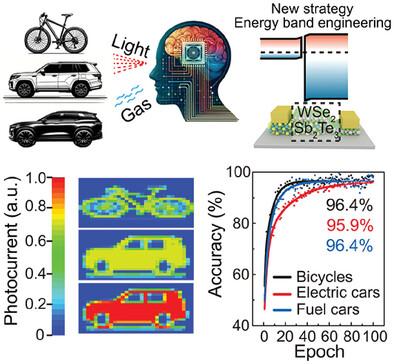Van der Waals Heterojunction Based Self-Powered Biomimetic Dual-Mode Sensor for Precise Object Identification
IF 27.4
1区 材料科学
Q1 CHEMISTRY, MULTIDISCIPLINARY
引用次数: 0
Abstract
The design and fabrication of materials that can concurrently respond to light and gas within the dual-modal recognition domain present a significant challenge due to contradictory structural requirements. This innovative strategy introduces a type-I heterojunction, combining the properties of Sb2Te3 and WSe2 nanosheets, to overcome these obstacles. The heterojunction is prepared through a precise stacking approach to create a single-side barrier on the valence band and a near-zero offset on the conduction band. The resulting Sb2Te3/WSe2 heterojunction demonstrates unparalleled performance, showcasing the best integrated photoelectric and gas sensing performance in a single device to date. Based on the above features, the heterojunction successfully integrates visual and olfactory sensing performance, achieving the first biomimetic visual-olfactory dual-mode recognition in a single device. This simulation increased the accuracy of distinguishing electric and fuel-powered cars from ≈50% to ≈96%. This work introduces a novel approach to creating efficient, self-powered sensing materials, paving the way for next-generation biomimetic dual-model devices with broad applications in environmental protection, medical care, and other fields.

基于范德华异质结的自供电仿生双模传感器用于精确识别物体
由于结构要求相互矛盾,设计和制造能在双模式识别领域内同时对光和气体做出反应的材料是一项重大挑战。这项创新战略引入了一种 I 型异质结,结合了 Sb2Te3 和 WSe2 纳米片的特性,从而克服了这些障碍。这种异质结是通过精确的堆叠方法制备的,从而在价带产生单侧势垒,在导带产生近乎零的偏移。由此产生的 Sb2Te3/WSe2 异质结具有无与伦比的性能,展示了迄今为止单一器件中最佳的光电和气体传感集成性能。基于上述特点,该异质结成功地整合了视觉和嗅觉传感性能,首次在单一器件中实现了仿生视觉-嗅觉双模式识别。这一模拟将区分电动汽车和燃油汽车的准确率从≈50%提高到≈96%。这项工作为创造高效、自供电的传感材料引入了一种新方法,为下一代生物仿真双模设备铺平了道路,该设备可广泛应用于环境保护、医疗保健和其他领域。
本文章由计算机程序翻译,如有差异,请以英文原文为准。
求助全文
约1分钟内获得全文
求助全文
来源期刊

Advanced Materials
工程技术-材料科学:综合
CiteScore
43.00
自引率
4.10%
发文量
2182
审稿时长
2 months
期刊介绍:
Advanced Materials, one of the world's most prestigious journals and the foundation of the Advanced portfolio, is the home of choice for best-in-class materials science for more than 30 years. Following this fast-growing and interdisciplinary field, we are considering and publishing the most important discoveries on any and all materials from materials scientists, chemists, physicists, engineers as well as health and life scientists and bringing you the latest results and trends in modern materials-related research every week.
 求助内容:
求助内容: 应助结果提醒方式:
应助结果提醒方式:


